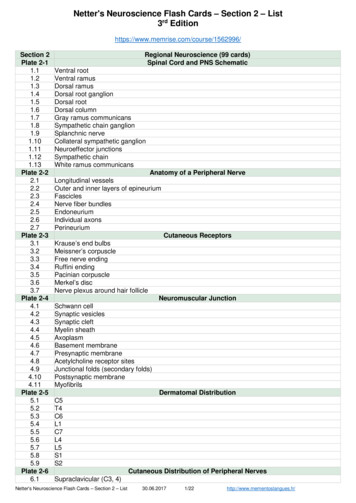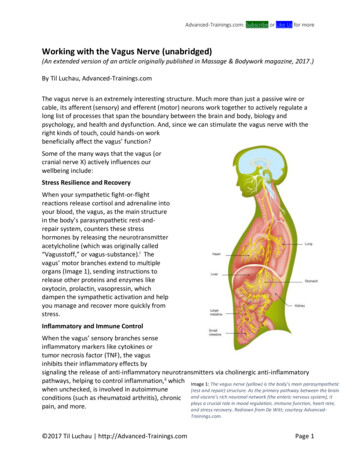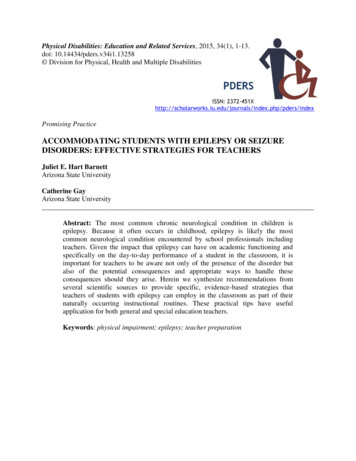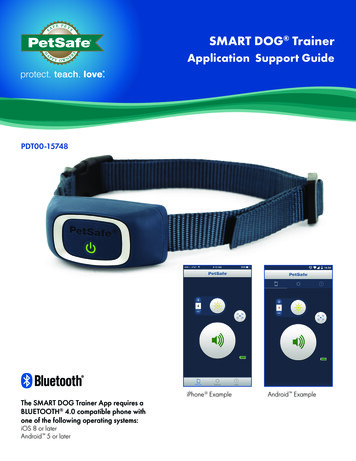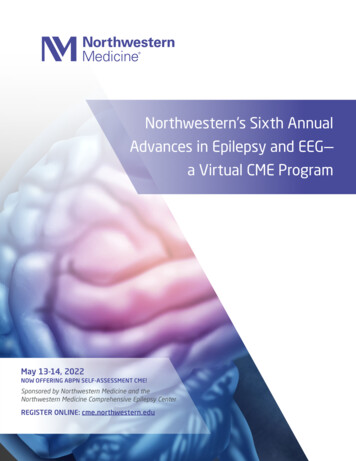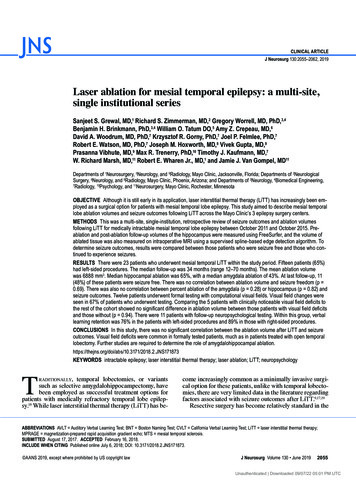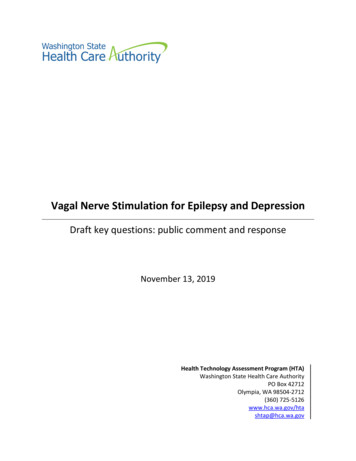
Transcription
Vagal Nerve Stimulation for Epilepsy and DepressionDraft key questions: public comment and responseNovember 13, 2019Health Technology Assessment Program (HTA)Washington State Health Care AuthorityPO Box 42712Olympia, WA 98504-2712(360) 725-5126www.hca.wa.gov/htashtap@hca.wa.gov
Vagal Nerve Stimulation for Epilepsy andDepressionDraft Key QuestionsPublic Comment and ResponseProvided by:Center for Evidence-based PolicyOregon Health & Science UniversityNovember 13, 2019
WA Health Technology AssessmentNovember 13, 2019Responses to Public Comment on Draft Key QuestionsThe Center for Evidence-based Policy is an independent vendor contracted to produce evidence assessment reportsfor the Washington Health Technology Assessment (HTA) program. For transparency, all comments received duringthe public comment periods are included in this response document. Comments related to program decisions,process, or other matters not pertaining to the evidence report are acknowledged through inclusion only.Draft key question document comments received: Edward J. Novotny, Jr., Head, Epilepsy Program, Seattle Children's Hospital, Professor ofNeurology, University of Washington, and Chair, Professional Advisory Board of EpilepsyFoundation of Washington Eliza Hagen, U.S. Medical Director, and Ryan Verner, Medical Affairs and Research Manager,Neuromodulation, LivaNova Nicole Curtis, patientSpecific responses pertaining to submitted comments are shown in Table 1.Vagal nerve stimulation for epilepsy and depression: draft key questions – public comment and responsePage 1
WA Health Technology AssessmentNovember 13, 2019Table 1. Responses to Comments on Draft Key Questions for Vagal Nerve Stimulation for Epilepsy andDepressionCommentsResponseCommenter: Edward J. Novotny, Jr., Head, Epilepsy Program, Seattle Children's Hospital, Professorof Neurology, University of Washington, and Chair, Professional Advisory Board ofEpilepsy Foundation of WashingtonGeneral Comments:As Director of the Epilepsy Program at Seattle Children's Hospital and current Chair of theProfessional Advisory Board of Epilepsy Foundation of Washington, I am addressing the keyquestions on the use of the neurostimulation device, vagus nerve stimulator (VNS), for thetreatment of epilepsy. I will focus on the use of this device in children and young adults withepilepsy.Thank you foryour comments.Please seedetailedresponses toyour specificcommentsbelow.Specific Comments:ClinicalCriteria forUse of VNSThe criteria for considering VNS at Seattle Children's Hospital are: (1) medicallyrefractory seizures; (2) adequate trials of at least 2 AEDs; (3) exclusion ofnonepileptic events; and (4) ineligibility for epilepsy surgery. All people beingconsidered for VNS are presented at our Epilepsy Surgery conference followingcompletion of a comprehensive epilepsy evaluation to investigate alternatives tomedical therapy.Thank you forthis informationon the use ofVNS at opoulos AV, Kotagal P, Loddenkemper T, Hammel J, Bingaman WE.Long-term results with vagus nerve stimulation in children withpharmacoresistant epilepsy. Seizure. 2006;15(7):491-503. doi:10.1016/j.seizure.2006.06.002.2.Ben-Menachem E, Hellstrom K, Verstappen D. Analysis of direct hospitalcosts before and 18 months after treatment with vagus nerve stimulationtherapy in 43 patients. Neurology. 2002;59(6 Suppl 4):S44-47. doi:10.1212/wnl.59.6 suppl 4.s44.Thank you foryour review ofVNS, along withsupportingreferences.3.Boon P, D'Have M, Van Walleghem P, et al. Direct medical costs ofrefractory epilepsy incurred by three different treatment modalities: aprospective assessment. Epilepsia. 2002;43(1):96-102. doi: 10.1046/j.15281157.2002.40100.x.4.Englot DJ, Hassnain KH, Rolston JD, Harward SC, Sinha SR, Haglund MM.Quality-of-life metrics with vagus nerve stimulation for epilepsy fromprovider survey data. Epilepsy Behav. 2017;66:4-9. doi:10.1016/j.yebeh.2016.10.005.5.Graves N. Anticonvulsants: choices and costs. Am J Manag Care. mers SL, Griesemer DA, Dean JC, et al. Observations on the use of vagusnerve stimulation earlier in the course of pharmacoresistant epilepsy:We will checkthe referencesagainst ourinclusion andexclusioncriteria for thisupdated report.Vagal nerve stimulation for epilepsy and depression: draft key questions – public comment and responsePage 2
WA Health Technology AssessmentNovember 13, 2019CommentsResponseCommenter: Edward J. Novotny, Jr., Head, Epilepsy Program, Seattle Children's Hospital, Professorof Neurology, University of Washington, and Chair, Professional Advisory Board ofEpilepsy Foundation of Washingtonpatients with seizures for six years or less. Neurologist. med/12808412.7.Klinkenberg S, Aalbers MW, Vles JS, et al. Vagus nerve stimulation inchildren with intractable epilepsy: a randomized controlled trial. Dev MedChild Neurol. 2012;54(9):855-861. doi: 10.1111/j.1469-8749.2012.04305.x.8.Morris GL, 3rd, Gloss D, Buchhalter J, Mack KJ, Nickels K, Harden C.Evidence-based guideline update: vagus nerve stimulation for the treatmentof epilepsy: report of the Guideline Development Subcommittee of theAmerican Academy of Neurology. Neurology. 2013;81(16):1453-1459. doi:10.1212/WNL.0b013e3182a393d1.9.Ryvlin P, So EL, Gordon CM, et al. Long-term surveillance of SUDEP in drugresistant epilepsy patients treated with VNS therapy. Epilepsia.2018;59(3):562-572. doi: 10.1111/epi.14002.Abbreviation. VNS: vagal nerve stimulation.CommentsResponseCommenter: Eliza Hagen, U.S. Medical Director, and Ryan Verner, Medical Affairs and ResearchManager, Neuromodulation, LivaNovaGeneral Comments:Vagus Nerve Stimulation (VNS) Therapy has helped U.S. patientsliving with drug-resistant epilepsy since 1997 and difficult-to-treatdepression (a.k.a treatment-resistant depression) since 2005, andcontinues to improve the lives of patients suffering from thesechronic diseases.Thank you for your comments.Please see detailed responses to yourspecific comments below.LivaNova PLC is pleased to offer comment on your proposedquestions for the upcoming health technology assessmentregarding VNS therapy for epilepsy and depression, with hopesthat patients in Washington will continue to benefit from thispotentially life changing therapy. Since your full technologyassessment for VNS therapy in 2009 and updated literature searchconducted by Hayes in 2013, investigators have continued toexplore the efficacy of this therapy with an evolving understandingof efficacious dosing based on therapeutic indication andmechanism, and we are confident that a holistic review of thenewly available data will yield a favorable view of the therapy.We have reviewed the key questions and scope of yourinvestigation and are pleased with the design and rigor.Vagal nerve stimulation for epilepsy and depression: draft key questions – public comment and responsePage 3
WA Health Technology AssessmentCommentsNovember 13, 2019ResponseCommenter: Eliza Hagen, U.S. Medical Director, and Ryan Verner, Medical Affairs and ResearchManager, Neuromodulation, LivaNovaWe thank you for examining the available evidence regarding thesafety and efficacy of VNS therapy once again and we look forwardto participating in the process and providing comments on yourdraft technology assessment. Should you have any questions orneed additional information, please let us know.Specific Comments:SafetyBackgroundPrior to addressing comments on the keyquestions and scope of your investigation, wewould like to comment on your “high concerns”for the safety of VNS. VNS Therapy has beenimplanted in over 100,000 patients worldwide andhas developed a well-characterized safety recordfor over 25 years. The primary procedure-relatedadverse event is infection, which occurs inapproximately 0.7-8.4% (depending on thereview/hospital) of patients. Stimulation-relatedadverse events, such as voice alteration, coughing,pharyngitis, paresthesia, dyspnea, dyspepsia, andnausea, are mild and often diminish with time.Further, such adverse events are often limited towhen the device actively delivers stimulation. Themild nature of these side-effects, in combinationwith the device’s clinical benefit for the patient,result in the vast majority of patients ( 80% inEpilepsy) electing to have their device replacedafter the original device’s battery is depleted.Thank you for your comments and thesummary information on the safety of VNS.We will review the adverse effects of VNStherapy as part of the updated report.Additionally, in the background of your memo you Thank you for your comments.reference the decision of the Center for MedicareThis clarification has now been added to theand Medicaid Services (CMS) to re-evaluate VNSBackground section.therapy for Depression based upon the strength ofthe data that has emerged since the non-coveragedecision in 2007. As part of that decision to coverVNS therapy for TRD through Coverage withEvidence Development, CMS also added coveragefor replacement of generators/leads for thoseMedicare beneficiaries previously implanted withVNS for TRD. This is not part of the RECOVERclinical trial, but coverage is effective February15th, 2019 and applies to all Medicarebeneficiaries in both FFS and Medicare Advantageplans.Vagal nerve stimulation for epilepsy and depression: draft key questions – public comment and responsePage 4
WA Health Technology AssessmentCommentsNovember 13, 2019ResponseCommenter: Eliza Hagen, U.S. Medical Director, and Ryan Verner, Medical Affairs and ResearchManager, Neuromodulation, LivaNovaPopulation1. Populations.Thank you for your comments.The populations studied should be consistent with a.FDA-approved VNS Therapy is FDA-approvedindications:a.b.PopulationThe VNS Therapy System is indicated for useas an adjunctive therapy in reducing thefrequency of seizures in patients 4 years ofage and older with partial onset seizures thatare refractory to antiepileptic medications.i. Thus, the population for epilepsy shouldbe modified to “Adults and children (aged4 and older)” with epilepsyii. The population should not excludepatients who also have status epilepticusalong with other seizure types. Patientswith very severe, drug-resistant epilepsymay also have status epilepticus.iii. Studies that exclusively study patientswho only experience psychogenic nonb.epileptic seizures, aka pseudoseizures,should be excluded. As written,pseudoseizures are included.The VNS Therapy System is indicated for theadjunctive long-term treatment of chronic orrecurrent depression for patients 18 years ofage or older who are experiencing a majordepressive episode and have not had anadequate response to four or more adequateantidepressant treatments.i. Thus, the population for TRD should bemodified to clearly state the definition ofTRD that is consistent with the VNSTherapy indications, e.g., patientssuffering from major depressive disorder4. Please note that the clinical definition of TRDdiffers slightly from our indication for use.The clinical definition of TRD requires failures of 2sufficient courses of adequately toleratedtherapies. Our indication for VNS Therapy inDepression is for adjunctive longterm treatment ofchronic or recurrent depression patients who havefailed 4 or more therapies.Population6. For our CMS-approved trial in depression, weare excluding patients with acute suicidal risk orWe have not restricted the review toany specific type of epilepsy. However,we will note any studies included in theupdated review that evaluate the use ofVNS for nonFDA-approved indications(other than status epilepticus alone).i. See aboveii. We will include studies in peoplewith epilepsy who also have statusepilepticus, but we will excludestudies where the focus of VNStreatment is only for statusepilepticus.iii. We did plan to exclude studies inpeople with psychogenic nonepileptic seizures however, wehave amended the text to makethis more explicit.We have restricted the review totreatment-resistant depression,regardless of how this is defined in thestudies. However, we will note anystudies included in the updated reviewthat evaluate the use of VNS fornonFDA-approved indications.Thank you for your comment.We have restricted the review to treatmentresistant depression, regardless of how thisis defined in the studies. However, we willnote any studies included in the updatedreview that evaluate the use of VNS fornonFDA-approved indications.Thank you for your comment.Vagal nerve stimulation for epilepsy and depression: draft key questions – public comment and responsePage 5
WA Health Technology AssessmentCommentsNovember 13, 2019ResponseCommenter: Eliza Hagen, U.S. Medical Director, and Ryan Verner, Medical Affairs and ResearchManager, Neuromodulation, LivaNovaInterventionrecent suicide attempt ( 6 months), active primarydiagnosis of obsessive-compulsive disorder, eatingdisorder, or post-traumatic stress disorder, andpresence or history of rapid-cycling bipolardisorder, personality disorder, dementia, orpsychiatric disorder. Thus, the study population forVNS in Depression should reflect these exclusions.We note that this is consistent with other nonpharmacological treatments, such as rTMS, whosesafety and effectiveness has not been establishedin these populations.We acknowledge that other studies mayhave different exclusion criteria, and thesewill be reported in detail in the evidencetables. We will also note how the studiesincluded in the updated review vary in theirpatient populations. We will also note anystudies included in the updated reviewwhose populations differ from thosemeeting FDA-approved indications.5. Transcutaneous VNS systems are not FDAapproved or cleared for use in Epilepsy orDepression and should not be included in thescope of this study.Thank you for your comment.We do note that the use of transcutaneousVNS systems is not FDA-approved and thiswill be explicitly noted in the updatedreport.Comparator(s) 2. As such, the assessment of VNS monotherapy,Thank you for your comment.as included in your current scope, would assessWe have not restricted the review to FDAoff-label application of the therapy and potentiallyapproved indications alone. However, wemake such analysis irrelevant.will note any studies included in theWe would recommend that such comparisons are updated review that evaluate the use of VNSremoved from the proposal.for nonFDA-approved indications (e.g., VNSmonotherapy).Comparator(s) 3. The FDA approved indication for VNS therapy in Thank you for your comment.depression is broader than the proposed definitionWe have amended this in line with yourused in the inclusion criteria. VNS Therapy must besuggestion.an adjunctive therapy per the labeling, but it canbe delivered with any other non-contraindicatedtreatment-as-usual (TAU) therapy, not justpharmacotherapies. Thus, comparisons of thetherapy should always be considered as VNS TAUversus TAU aloneComparator(s) 7. Comparator studies:a.b.Epilepsyi. Should explicitly include ResponsiveNeurostimulation (RNS) and Deep BrainStimulation (DBS), as these are the onlyother device-based therapies indicatedfor drug-resistant epilepsy.Depressioni. Patient population should be carefullyselected to approximate the patientThank you for your comments.a.b.We will include any studies comparingVNS with any other form of brainstimulation (invasive or noninvasive),including RNS and DBS. We will noteany comparator that is not FDAapproved for epilepsy in the updatedreport.We have restricted the review totreatment-resistant depression,Vagal nerve stimulation for epilepsy and depression: draft key questions – public comment and responsePage 6
WA Health Technology AssessmentCommentsNovember 13, 2019ResponseCommenter: Eliza Hagen, U.S. Medical Director, and Ryan Verner, Medical Affairs and ResearchManager, Neuromodulation, LivaNovac.Outcome(s)population in studies of VNS Therapy. VNSTherapy is indicated after 4 or moretreatment failures. In the D-23 studypatients had failed nearly 9 treatments, inother words were significantly moresevere and refractory than the clinicaldefinition of TRD which is 2 or morefailures. Thus, patient inclusion criteriawill be important so as not to introducebias in any comparison made.c.Studies of comparator therapies can be quiteshort in duration ( 6 weeks). Directcomparison of other therapies with VNS onthe same timeline may result in an opinionthat VNS therapy is less effective orineffective. Please note that VNS Therapyrequires a post-operative recovery period andtitration period, and evidence suggests thatthe anti-convulsive and anti-depressivebenefit builds with time and is quite durable.Based on available data, we recommend atleast a 1 year follow-up for comparisonstudies.8. Outcomes:a.b.c.regardless of how this is defined in thestudies. However, we will note anystudies included in the updated reviewthat evaluate the use of VNS fornonFDA-approved indications. We willalso explore any differences ineffectiveness and harms by patientcharacteristics (e.g., severity ofdepression).We have not restricted the review bystudy duration. We will explore anydifferences in effectiveness and harmsby study duration, in order to addresskey question 3 for epilepsy anddepression.Thank you for your comments.Epilepsya.i. Please add Seizure Severity (SSQ) andDuration of Seizure as efficacy outcomesDepressionb.i. Please specify which depression severityscale(s) you intend to use to clarify whatremission means.ii. Please include duration of response,duration of remission, long-termcompliance with therapy, suicidality, andoverall mortality as secondary outcomesas these have emerged in the literature asimportant considerations in thec.evaluation of VNS therapy.Health benefits outcomes should also considerthe high burden these severely refractorypatients place on the healthcare system. Thisis especially true in cases of difficult-to-treatdepression. Further, given that many severelyrefractory patients don’t have access or arenot quickly referred for surgical or devicebased therapies, consideration should beWe have added in the outcomes ofseizure severity and duration assuggested.Studies may use different validatedtools to assess depression severity. Wewill therefore include any measure ofdepression severity, if assessed using avalidated tool. We have also added inthe suggested outcomes of duration ofresponses and remission, compliance,suicidality, and mortality, if assessed bya validated tool or method.We will capture issues of resource usewhen addressing key question 4 forepilepsy and depressionVagal nerve stimulation for epilepsy and depression: draft key questions – public comment and responsePage 7
WA Health Technology AssessmentCommentsNovember 13, 2019ResponseCommenter: Eliza Hagen, U.S. Medical Director, and Ryan Verner, Medical Affairs and ResearchManager, Neuromodulation, LivaNovamade of the economic impact of an untreatedpatientOutcome(s)Outcome(s)Sources9. Assessment of harms should be fair andbalanced. If harms are assessed for VNS Therapy,harms associated with other similar therapiesshould also be examined.Thank you for your comment.10. We would prefer a distinction between direct“harms” and “side-effects”. We feel that listingintermittent voice alteration or coughing as a“harm” may be disingenuous to the severity of theevent.Thank you for your comment.11. Sources:Thank you for your comments.a.b.We will report adverse events for both theintervention of VNS and the comparatorinterventions.We use the term ‘direct-harm’ to describeeffects that are directly related to theintervention or comparator in the includedstudies. This could include mild effects, suchas coughing, or more serious effects, such asinfection. We will discuss the impact of thefull range of adverse effects in the updatedreview.Clinicaltrials.gov should be included as aa.source for efficacy and harms data as data arepresented in accordance with the CONSORTstatement and the protocol and reviewed bytrained personnel at the Department ofHealth and Human Services.b.Labeling approved by FDA as part of a PMAshould be considered as a source of data.We will report efficacy and harm dataas reported in the published literature.We will search Clinicaltrials.gov forongoing studies and studies that haverecently completed.We will not use the PMA report as asource of effectiveness or harms, butwe will report efficacy and harm datafrom the published literature. However,we will include information on the FDAapproved indications (as specified in thelabelling documentation).Abbreviations. PMA: pre-marketing approval; rTMS: repetitive transcranial magnetic stimulation; VNS: vagal nervestimulation.Vagal nerve stimulation for epilepsy and depression: draft key questions – public comment and responsePage 8
WA Health Technology AssessmentNovember 13, 2019CommentsResponseCommenter: Nicole CurtisGeneral Comments:On 11/5/2018 I was under " conscious sedation" for a very minor procedure in ahospital.because I refused to have it done in office. At the end of the biopsy, I suddenlywent bradycardic and then went into Asystole, full code blue.Thank youfor your comments.I have had nothing but road blocks and denials in trying to determine cause of my SCA. TheVNS company IGNORED request from the anesthesiologist to come to the ICU andinterrogate the device. They ignored my primary doctors. I had to date more than 6months and spend a days travel and more expense to go to down town Seattle to SwedishCherry Hill. The VNS tech's would NOT EVEN MAKE EYE CONTACT WITH ME!I happen to know about the recalls on model 106.I have model 102. I got mine back in Illinois. Once I moved out here.I found follow up careimpossible.I am still seeking answers.Was my SCA related to VNS?. was is long QTC syndrome?.was it anaphylaxis? I haveseen 3 specialists.AND NONE OF THEM DID ANY TESTS.ONE DID A MINOR EXAM. eachsending me back to the other. I am the proverbial HOT POTATO!I am more than disappointed in the "healthcare" i have received in the Washington statearea.Vagal nerve stimulation for epilepsy and depression: draft key questions – public comment and responsePage 9
To whom it may concern:Vagus Nerve Stimulation (VNS) Therapy has helped U.S. patients living with drug-resistantepilepsy since 1997 and difficult-to-treat depression (a.k.a treatment-resistant depression) since2005, and continues to improve the lives of patients suffering from these chronic diseases.LivaNova PLC is pleased to offer comment on your proposed questions for the upcoming healthtechnology assessment regarding VNS therapy for epilepsy and depression, with hopes thatpatients in Washington will continue to benefit from this potentially life changing therapy. Sinceyour full technology assessment for VNS therapy in 2009 and updated literature search conductedby Hayes in 2013, investigators have continued to explore the efficacy of this therapy with anevolving understanding of efficacious dosing based on therapeutic indication and mechanism,and we are confident that a holistic review of the newly available data will yield a favorable viewof the therapy.Prior to addressing comments on the key questions and scope of your investigation, we wouldlike to comment on your “high concerns” for the safety of VNS. VNS Therapy has beenimplanted in over 100,000 patients worldwide and has developed a well-characterized safetyrecord for over 25 years. The primary procedure-related adverse event is infection, which occursin approximately 0.7-8.4% (depending on the review/hospital) of patients. Stimulation-relatedadverse events, such as voice alteration, coughing, pharyngitis, paresthesia, dyspnea, dyspepsia,and nausea, are mild and often diminish with time. Further, such adverse events are often limitedto when the device actively delivers stimulation. The mild nature of these side-effects, incombination with the device’s clinical benefit for the patient, result in the vast majority ofpatients ( 80% in Epilepsy) electing to have their device replaced after the original device’sbattery is depleted.Additionally, in the background of your memo you reference the decision of the Center forMedicare and Medicaid Services (CMS) to re-evaluate VNS therapy for Depression based uponthe strength of the data that has emerged since the non-coverage decision in 2007. As part of thatdecision to cover VNS therapy for TRD through Coverage with Evidence Development, CMSalso added coverage for replacement of generators/leads for those Medicare beneficiariespreviously implanted with VNS for TRD. This is not part of the RECOVER clinical trial, butcoverage is effective February 15th, 2019 and applies to all Medicare beneficiaries in both FFSand Medicare Advantage plans.LivaNova USA,a wholly-owned subsidiaryof LivaNova PLC100 Cyberonics Blvd.Houston, TX 77058T 01 866-332-1375www.livanova.com1
We have reviewed the key questions and scope of your investigation and are pleased with thedesign and rigor. In order to clarify some points and to help identify additional comparators andoutcomes for VNS Therapy, we have the following comments:1) Populations:The populations studied should be consistent with FDA-approved VNS Therapy is FDAapproved indications:a. The VNS Therapy System is indicated for use as an adjunctive therapy inreducing the frequency of seizures in patients 4 years of age and older with partialonset seizures that are refractory to antiepileptic medications.i. Thus, the population for epilepsy should be modified to “Adults andchildren (aged 4 and older)” with epilepsyii. The population should not exclude patients who also have statusepilepticus along with other seizure types. Patients with very severe, drugresistant epilepsy may also have status epilepticus.iii. Studies that exclusively study patients who only experience psychogenicnon-epileptic seizures, aka pseudoseizures, should be excluded. Aswritten, pseudoseizures are included.b. The VNS Therapy System is indicated for the adjunctive long-term treatment ofchronic or recurrent depression for patients 18 years of age or older who areexperiencing a major depressive episode and have not had an adequate response tofour or more adequate antidepressant treatments.i. Thus, the population for TRD should be modified to clearly state thedefinition of TRD that is consistent with the VNS Therapy indications,e.g., patients suffering from major depressive disorder2) As such, the assessment of VNS monotherapy, as included in your current scope, wouldassess off-label application of the therapy and potentially make such analysis irrelevant.We would recommend that such comparisons are removed from the proposal.LivaNova USA,a wholly-owned subsidiaryof LivaNova PLC100 Cyberonics Blvd.Houston, TX 77058T 01 866-332-1375www.livanova.com2
3) The FDA approved indication for VNS therapy in depression is broader than the proposeddefinition used in the inclusion criteria. VNS Therapy must be an adjunctive therapy perthe labeling, but it can be delivered with any other non-contraindicated treatment-as-usual(TAU) therapy, not just pharmacotherapies. Thus, comparisons of the therapy shouldalways be considered as VNS TAU versus TAU alone.4) Please note that the clinical definition of TRD differs slightly from our indication for use.The clinical definition of TRD requires failures of 2 sufficient courses of adequatelytolerated therapies. Our indication for VNS Therapy in Depression is for adjunctive longterm treatment of chronic or recurrent depression patients who have failed 4 or moretherapies.5) Transcutaneous VNS systems are not FDA approved or cleared for use in Epilepsy orDepression and should not be included in the scope of this study.6) For our CMS-approved trial in depression, we are excluding patients with acute suicidalrisk or recent suicide attempt ( 6 months), active primary diagnosis of obsessivecompulsive disorder, eating disorder, or post-traumatic stress disorder, and presence orhistory of rapid-cycling bipolar disorder, personality disorder, dementia, or psychiatricdisorder. Thus, the study population for VNS in Depression should reflect theseexclusions. We note that this is consistent with other non-pharmacological treatments,such as rTMS, whose safety and effectiveness has not been established in thesepopulations.7) Comparator studies:a. Epilepsyi. Should explicitly include Responsive Neurostimulation (RNS) and DeepBrain Stimulation (DBS), as these are the only other device-basedtherapies indicated for drug-resistant epilepsy.b. Depressioni. Patient population should be carefully selected to approximate the patientpopulation in studies of VNS Therapy. VNS Therapy is indicated after 4 ormore treatment failures. In the D-23 study patients had failed nearly 9LivaNova USA,a wholly-owned subsidiaryof LivaNova PLC100 Cyberonics Blvd.Houston, TX 77058T 01 866-332-1375www.livanova.com3
treatments, in other words were significantly more severe and refractorythan the clinical definition of TRD which is 2 or more failures. Thus,patient inclusion criteria will be important so as not to introduce bias inany comparison made.c. Studies of comparator therapies can be quite short in duration ( 6 weeks). Directcomparison of other therapies with VNS on the same timeline may result in anopinion that VNS therapy is less effective or ineffective. Please note that VNSTherapy requires a post-operative recovery period and titration period, andevidence suggests that the anti-convulsive and anti-depressive benefit builds withtime and is quite durable. Based on available data, we recommend at least a 1year follow-up for comparison studies.8) Outcomes:a. Epilepsyi. Please add Seizure Severity (SSQ) and Duration of Seizure as efficacyoutcomesb. Depressioni. Please specify which depression severity scale(s) you intend to use toclarify
Neurology, University of Washington, and Chair, Professional Advisory Board of Epilepsy Foundation of Washington Eliza Hagen, U.S. Medical Director, and Ryan Verner, Medical Affairs and Research Manager, Neuromodulation, LivaNova Nicole Curtis, patient Specific responses pertaining to submitted comments are shown in Table 1.
